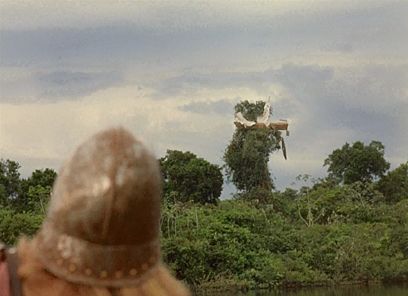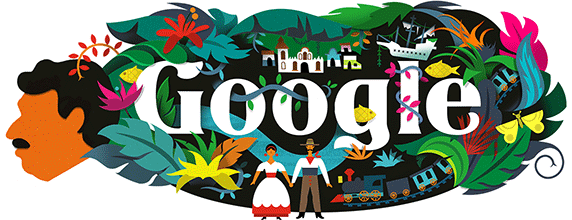Long ago I first saw the movie "Aguirre, Wrath of God," about a Spanish conquistador going nuts amid a disastrous Peruvian expedition. Here's a memorable image from that film:

It's Aguirre regarding the wreck of a sailing vessel in a tree. Why is it there? How did it get into a tree? What can I say, it's a peculiar movie. Even so, the ship is a very odd element that makes no contribution to the plot beyond weirdness. Of course everyone remembers the ship years after having watched the movie.
******************************************************************************

Right away the tilted ship that seems perched on the letter "l" reminded me of Aguirre's wreck. Given that the movie and Garcia's stories take place in South America, are the two ships related? An article about the doodle linked the ship to Garcia's best-known novel, "One Hundred Years of Solitude." Checking online, I found this relevant bit from the book:
"Always following his compass, he kept on guiding his men toward the invisible north so that they would be able to get out of that enchanted region. It was a thick night, starless, but the darkness was becoming impregnated with a fresh and clear air. Exhausted by the long crossing, they hung up their hammocks and slept deeply for the first time in two weeks. When they woke up, with the sun already high in the sky, they were speechless with fascination. Before them, surrounded by ferns and palm trees, white and powdery in the silent morning light, was an enormous Spanish galleon. Tilted slightly to the starboard, it had hanging from its intact masts the dirty rags of its sails in the midst of its rigging, which was adorned with orchids. The hull, covered with an armor of petrified barnacles and soft moss, was firmly fastened into a surface of stones. The whole structure seemed to occupy its own space, one of solitude and oblivion, protected from the vices of time and the habits of the birds. Inside, where the expeditionaries explored with careful intent, there was nothing but a thick forest of flowers. The discovery of the galleon, an indication of the proximity of the sea, broke Jos Arcadio Buenda's drive. He considered it a trick of his whimsical fate to have searched for the sea without finding it, at the cost of countless sacrifices and suffering, and to have found it all of a sudden without looking for it, as if it lay across his path like an insurmountable object. Many years later Colonel Aureliano Buenda crossed the region again, when it was already a regular mail route, and the only part of the ship he found was its burned-out frame in the midst of a field of poppies. Only then, convinced that the story had not been some product of his father's imagination, did he wonder how the galleon had been able to get inland to that spot. But Jos Arcadio Buenda did not concern himself with that when he found the sea after another four days' journey from the galleon. His dreams ended as he faced that ashen, foamy, dirty sea, which had not merited the risks and sacrifices of the adventure."
Which is very much like the mood of the movie. So I wonder:
1. In general, did this passage have any influence on the movie?
2. In particular, did this passage prompt the inclusion of the ship in the tree?
3. Did the doodle artist regard his ship as an allusion to the ship in the tree?
I like to answer yes to all three.

2 comments:
trying to get in the mind of Werner Herzog will likely lead you see more than ships in trees.
Thanks for sharinng
Post a Comment